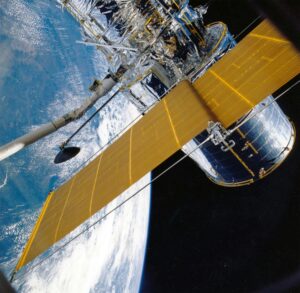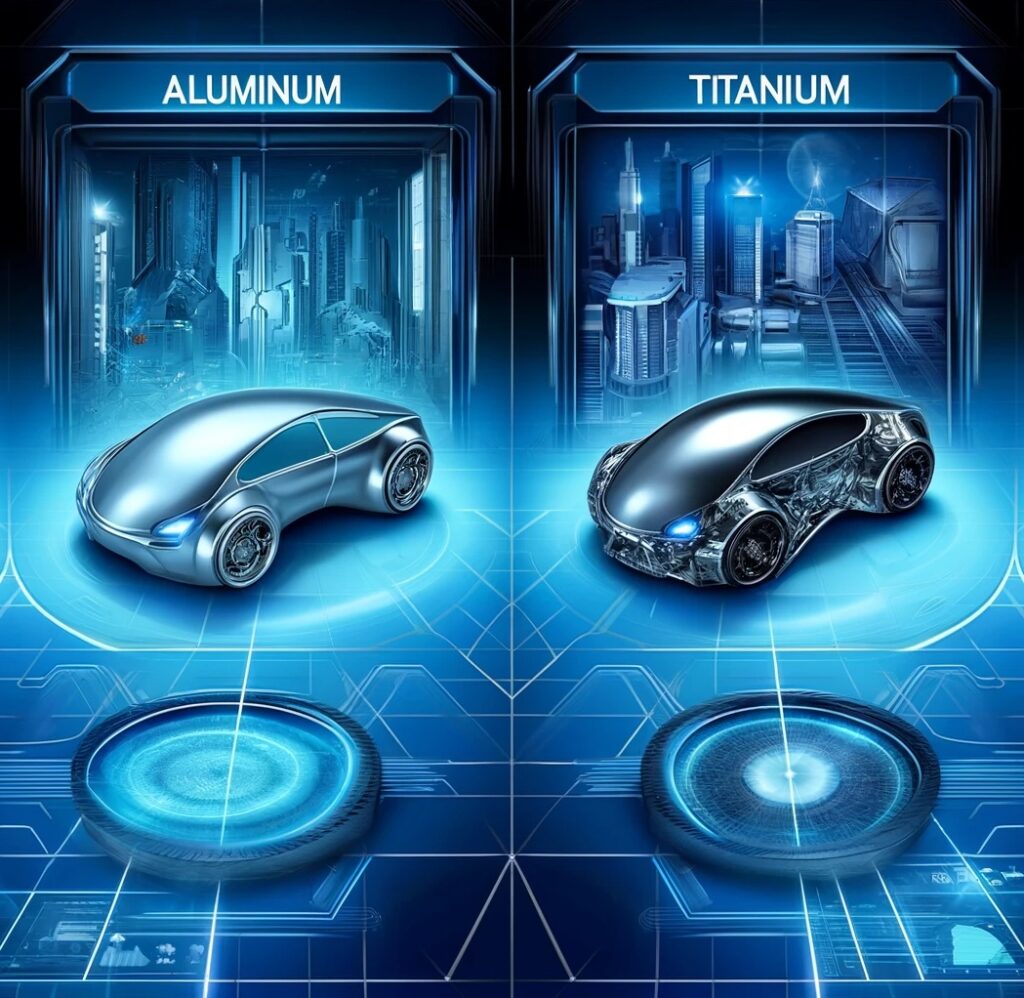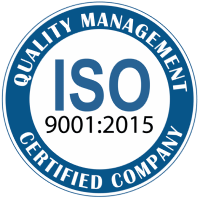-
Properties and Characteristics
1.1 Core Physical Properties of Aluminum and Titanium
Aluminum and titanium exhibit distinct physical properties. Aluminum, with a density of 2.7 g/cm³, is lighter than titanium, which has a density of 4.5 g/cm³. Aluminum melts at 660.3°C, whereas titanium’s melting point is much higher at 1668°C. Aluminum excels in electrical and thermal conductivity, while titanium offers superior strength and hardness. Despite being denser, titanium’s exceptional strength allows for lighter structures. Aluminum is more flexible and ductile, making it easier to fabricate into various shapes. These differences significantly influence their application in industries requiring specific physical properties.
References:
1.2 Chemical Properties
Aluminum is highly reactive, forming an oxide layer that offers corrosion resistance, but it corrodes in acidic and alkaline environments. Titanium, also forming a protective oxide layer, is more resistant to a broader range of chemicals, including acids. Aluminum’s reactivity limits its use in harsh conditions, whereas titanium’s stability makes it suitable for demanding environments. Both metals alloy with other elements to enhance their properties, with titanium’s inertness and biocompatibility making it ideal for medical implants and aerospace components.
References:
1.3 Mechanical Properties
Aluminum is known for its excellent machinability and moderate strength, with a tensile strength of 90 MPa and a yield strength of 30 MPa. It is elastic and flexible but less tough and fatigue-resistant than titanium. Titanium, with a tensile strength of 434 MPa and a yield strength of 275 MPa, offers superior toughness, fatigue resistance, and hardness. However, it is harder to machine. Aluminum wears out faster than titanium, which boasts better wear resistance, making it suitable for demanding applications.
References:
- Davis, J.R. (1998). ASM Specialty Handbook: Aluminum and Aluminum Alloys. ASM International.
- Leyens, C., & Peters, M. (2003). Titanium and Titanium Alloys: Fundamentals and Applications. Wiley-VCH.

-
Applications and Uses
2.1 Aerospace Industry
Aluminum and titanium are extensively used in the aerospace industry. Aluminum’s lightweight nature and good manufacturability make it ideal for airframes and fuselage structures, enhancing fuel efficiency. Titanium, with superior strength, heat resistance, and fatigue life, is used in critical components like jet engines and landing gear. Both metals contribute to improved aerodynamics and structural integrity. While aluminum is more cost-effective, titanium’s higher material cost is justified by its performance in high-stress environments.
References:
- Miller, R.E. (2011). Aerospace Materials. John Wiley & Sons.
- Callister, W.D., & Rethwisch, D.G. (2018). Materials Science and Engineering: An Introduction. John Wiley & Sons.
2.2 Automotive Industry
Aluminum and titanium play crucial roles in the automotive industry. Aluminum’s lightweight nature and cost-effectiveness improve fuel efficiency and reduce emissions. It is widely used in engine blocks, body panels, and wheels. Titanium, though more expensive, offers exceptional strength, crashworthiness, and performance, particularly in high-end and sports cars. Both metals contribute to design flexibility and sustainability, with aluminum being highly recyclable. Their combined use enhances vehicle safety and longevity.
References:
- Davies, G. (2003). Materials for Automobile Bodies. Butterworth-Heinemann.
- Schaffer, J.P., et al. (2012). The Science and Design of Engineering Materials. McGraw-Hill Education.

2.3 Construction and Architecture
Aluminum and titanium are crucial in modern construction and architecture. Aluminum, known for its structural strength and corrosion resistance, is used in window frames, curtain walls, and roofing. Its aesthetic appeal and cost-effectiveness make it a popular choice. Titanium, with superior strength and corrosion resistance, is used in iconic structures and facades, providing longevity and a sleek appearance. Both metals contribute to sustainability through recyclability and energy efficiency. Ease of installation and good thermal conductivity further enhance their applications in the building industry.
References:
- Schodek, D.L., & Bechthold, M. (2008). Structures. Prentice Hall.
- Ashby, M.F., & Johnson, K. (2014). Materials and Design: The Art and Science of Material Selection in Product Design. Butterworth-Heinemann.
2.4 Consumer Products
Aluminum and titanium are integral to consumer products. Aluminum’s lightweight, durability, and cost-effectiveness make it ideal for items like laptops, smartphones, and kitchenware. Its aesthetic appeal and recyclability further enhance its use. Titanium, known for its superior strength and lightweight, is used in high-end consumer products such as watches, eyewear, and sports equipment. Its biocompatibility makes it suitable for medical devices. Both metals offer safety and longevity, meeting the high market demand for durable and versatile products.
References:
- Ashby, M.F., Shercliff, H., & Cebon, D. (2013). Materials: Engineering, Science, Processing and Design. Butterworth-Heinemann.
- Callister, W.D., & Rethwisch, D.G. (2018). Materials Science and Engineering: An Introduction. John Wiley & Sons.
-
Advantages and Disadvantages
3.1 Aluminum: Advantages
Aluminum offers numerous advantages. It is lightweight, which enhances fuel efficiency and reduces transportation costs. Its cost-effectiveness makes it accessible for various applications. Aluminum’s natural corrosion resistance extends its lifespan, while its excellent conductivity is ideal for electrical applications. It is highly recyclable, contributing to sustainability. Versatility in manufacturing allows for diverse applications, and its abundance ensures a steady supply. Additionally, aluminum is easy to fabricate, further enhancing its appeal in industries such as aerospace, automotive, and construction.
References:
3.2 Aluminum: Disadvantages
Aluminum has several disadvantages. Its lower strength compared to materials like steel and titanium limits its use in high-stress applications. It is prone to fatigue, which can reduce its lifespan in cyclic loading conditions. Aluminum is less heat-resistant, making it unsuitable for high-temperature applications. Its softness makes it more prone to scratches and dents. The metal’s higher thermal expansion can cause issues in precise assemblies, and its lower wear resistance affects its durability in abrasive environments.
References:
- Davis, J.R. (1998). ASM Specialty Handbook: Aluminum and Aluminum Alloys. ASM International.
- Polmear, I.J. (2006). Light Alloys: From Traditional Alloys to Nanocrystals. Elsevier.
3.3 Titanium: Advantages
Titanium offers numerous advantages. Its high strength-to-weight ratio allows for robust yet lightweight structures. Titanium’s corrosion resistance ensures longevity, even in harsh environments. It is biocompatible, making it suitable for medical implants. The metal’s high heat resistance enables use in high-temperature applications, and its durability ensures a long service life. Additionally, titanium has low thermal expansion and high fatigue resistance, making it ideal for aerospace and other demanding industries.
References:
- Leyens, C., & Peters, M. (2003). Titanium and Titanium Alloys: Fundamentals and Applications. Wiley-VCH.
- Froes, F.H. (2015). Titanium: Physical Metallurgy, Processing, and Applications. ASM International.
3.4 Titanium: Disadvantages
Titanium has several disadvantages. It is expensive, partly due to its complex extraction and processing methods. The metal is difficult to machine and weld, increasing fabrication costs. Titanium is less abundant than other metals, leading to limited availability and higher prices. Its high reactivity requires special handling during processing, further complicating its use in manufacturing. These factors make titanium less accessible for widespread applications, despite its superior properties.
References:
- Leyens, C., & Peters, M. (2003). Titanium and Titanium Alloys: Fundamentals and Applications. Wiley-VCH.
- Froes, F.H. (2015). Titanium: Physical Metallurgy, Processing, and Applications. ASM International.
-
Cost, Availability, and Economic Impact
4.1 Comparative Raw Material Costs
Aluminum is generally less expensive than titanium. The market price of aluminum fluctuates around $1,800 per ton, while titanium’s price can exceed $10,000 per ton due to complex extraction processes and limited supply. Aluminum’s abundant availability and lower mining costs contribute to its affordability. In contrast, titanium’s extraction is energy-intensive and geopolitically sensitive, impacting its price. Demand for both metals affects their price volatility, with titanium being more prone to price swings due to its specialized applications.
References:
4.2 Processing Costs
Processing costs for aluminum are generally lower than for titanium. Aluminum is easier to machine and fabricate, reducing labor and energy costs. Titanium’s higher melting point and reactivity require more expensive heat treatments and specialized equipment, increasing energy and labor costs. Alloying titanium is also costlier due to the need for high-purity materials and advanced processes. Waste management and quality control are more demanding for titanium, further driving up costs. Overall, titanium’s processing is more complex and costly compared to aluminum.
References:
- Totten, G.E., & MacKenzie, D.S. (2003). Handbook of Aluminum: Vol. 1: Physical Metallurgy and Processes. CRC Press.
- Froes, F.H. (2015). Titanium: Physical Metallurgy, Processing, and Applications. ASM International.
4.3 Market Availability
Aluminum is more widely available than titanium due to its abundant natural reserves and extensive supply chain. Global production of aluminum is robust, with significant output from countries like China, Russia, and Canada. Titanium’s availability is more restricted, with major production centers in Australia, South Africa, and China. Import and export dynamics significantly affect both metals, with aluminum being more accessible due to its higher production capacity and stable supply chain. Demand fluctuations and regional availability can impact market trends and prices, with titanium experiencing more volatility due to its specialized applications and limited production.
References:
-
Environmental and Sustainability Considerations
5.1 Energy Consumption in Production
Producing aluminum and titanium is energy-intensive. Aluminum extraction via electrolysis consumes vast amounts of electricity, contributing to its high energy footprint. Titanium production, especially the Kroll process, is also energy-demanding. Both metals require substantial energy for processing and manufacturing, impacting their carbon footprints. However, efforts to improve energy efficiency and incorporate renewable energy sources are ongoing. Regulatory measures are also in place to mitigate environmental impacts, promoting sustainable practices in the production of these metals.
References:
- Totten, G.E., & MacKenzie, D.S. (2003). Handbook of Aluminum: Vol. 1: Physical Metallurgy and Processes. CRC Press.
- Froes, F.H. (2015). Titanium: Physical Metallurgy, Processing, and Applications. ASM International.

5.2 Recycling and Sustainability
Aluminum and titanium are highly recyclable, significantly reducing their environmental impact. Aluminum recycling consumes 95% less energy than primary production, making it a cornerstone of sustainable practices. Titanium recycling is less common but growing, particularly in aerospace and medical industries. Lifecycle analysis of both metals shows substantial benefits from recycling, including reduced waste and lower carbon footprints. Sustainability practices, such as promoting a circular economy, enhance material recovery and environmental impact. Regulatory compliance further ensures these metals are produced and recycled in environmentally friendly ways.
References:
- Kaufman, J.G. (2000). Introduction to Aluminum Alloys and Tempers. ASM International.
- Froes, F.H. (2015). Titanium: Physical Metallurgy, Processing, and Applications. ASM International.
5.3 Long-term Environmental Effects
The production and use of aluminum and titanium have notable long-term environmental effects. Aluminum production can cause significant ecological disruption, including habitat destruction and water pollution. Titanium mining also impacts ecosystems, though it generally involves less environmental degradation. Both metals contribute to resource depletion; however, aluminum’s abundance makes it less critical than titanium. Pollution from processing these metals includes greenhouse gas emissions and toxic waste. Sustainability practices, regulatory impacts, and policies aim to mitigate these effects, promoting a lower environmental footprint and long-term benefits through recycling and reduced resource consumption.
References:
- Kaufman, J.G. (2000). Introduction to Aluminum Alloys and Tempers. ASM International.
- Froes, F.H. (2015). Titanium: Physical Metallurgy, Processing, and Applications. ASM International.
Conclusion
In comparing aluminum and titanium, each metal presents distinct advantages and disadvantages, making them suitable for different applications. Aluminum’s lightweight, cost-effectiveness, and excellent conductivity make it ideal for use in aerospace, automotive, construction, and consumer products. Its abundant availability and recyclability further enhance its appeal. However, aluminum’s lower strength and heat resistance limit its use in high-stress and high-temperature environments.
Titanium, on the other hand, offers superior strength, corrosion resistance, and biocompatibility, making it indispensable in aerospace, medical, and high-performance applications. Its higher cost, complex processing requirements, and limited availability pose challenges, but its exceptional properties justify its use in demanding conditions.
Ultimately, the choice between aluminum and titanium depends on specific project requirements, balancing factors like cost, strength, weight, and environmental impact. Both metals play crucial roles in advancing technology and industry, each excelling in its own realm.




